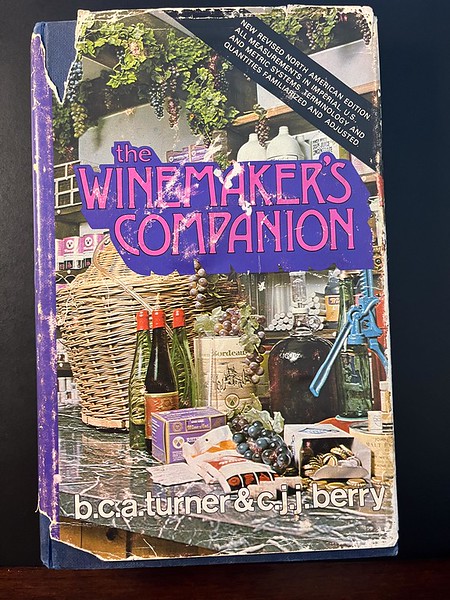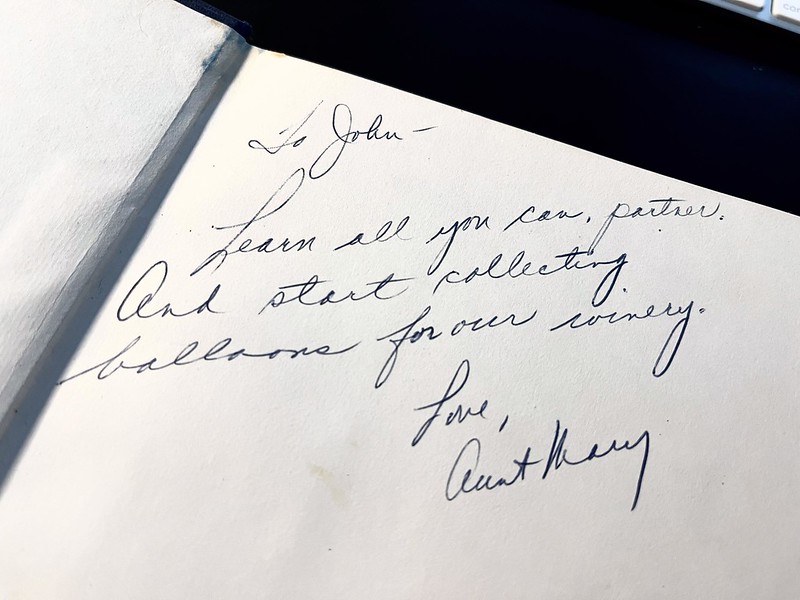Hello,
I've been making wine off-and-on, mostly off, since the early 1970s, when I was around 13. It started when a buddy of mine and I read about World War II POWs putting raisins into water and letting it ferment. We tried it ... and instead opted to sneak a little of his dad's jug wine instead.
I kept at it, mostly doing concord wine from store-bought juice. My parents weren't exactly thrilled, but probably figured there wasn't much harm I could do. My aunt Mary got wind of this and thought it was pretty interesting that a kid would be into this kind of thing. So, she went out and found this book for me:

I really love the inscription inside:

I continued making some wine: concord, elderberry, etc. Some friends and I took the plunge into beer brewing in the late 1980s and 1990s. But, kids came along and we gave it up. I made a few wines over the years, but started concentrating on ciders about 10 years ago. I made a few good ones, but nothing remarkable.
In 2022 I decided I'd try a couple kit wines. I did a Winexpert Super Tuscan and Chardonnay. This really got me interested in getting back into it. The Chardonnay is excellent, the Super Tuscan is good but a bit flabby. I think this is a good path for me going forward and I intend to do more.
My wife and I travelled to Ireland last summer. We were both smitten by the ciders there, and drank many dry ones over the two weeks we were there. MacIvor's was my favorite, but there were others that were excellent too. They're so much more flavorful and interesting than the sweet and thin ciders that are typical in the US. So, I struck out to improve my cider making last fall. After some research I used the same locally available juice I have used before (Louisburg Cider Mill, Kansas, USA), but upped the acid and tannin significantly from my previous recipes. I did 3 one-gallon batches, the only difference being the yeast used: Cote des Blancs, Nottingham and Safale S04. The differences in the three were quite interesting. We thought S04 was the winner, but CdB was a close second. Nottingham was out for both of us. The results were very good and very encouraging to me.
So, back to wine. The kit results were very encouraging too, and I'd like to do more of them. I have started reading the kit wine forum here, and am frankly overwhelmed by the large quantity of information. I hope to be able to learn and ultimately contribute here as well.
John
I've been making wine off-and-on, mostly off, since the early 1970s, when I was around 13. It started when a buddy of mine and I read about World War II POWs putting raisins into water and letting it ferment. We tried it ... and instead opted to sneak a little of his dad's jug wine instead.
I kept at it, mostly doing concord wine from store-bought juice. My parents weren't exactly thrilled, but probably figured there wasn't much harm I could do. My aunt Mary got wind of this and thought it was pretty interesting that a kid would be into this kind of thing. So, she went out and found this book for me:

I really love the inscription inside:

I continued making some wine: concord, elderberry, etc. Some friends and I took the plunge into beer brewing in the late 1980s and 1990s. But, kids came along and we gave it up. I made a few wines over the years, but started concentrating on ciders about 10 years ago. I made a few good ones, but nothing remarkable.
In 2022 I decided I'd try a couple kit wines. I did a Winexpert Super Tuscan and Chardonnay. This really got me interested in getting back into it. The Chardonnay is excellent, the Super Tuscan is good but a bit flabby. I think this is a good path for me going forward and I intend to do more.
My wife and I travelled to Ireland last summer. We were both smitten by the ciders there, and drank many dry ones over the two weeks we were there. MacIvor's was my favorite, but there were others that were excellent too. They're so much more flavorful and interesting than the sweet and thin ciders that are typical in the US. So, I struck out to improve my cider making last fall. After some research I used the same locally available juice I have used before (Louisburg Cider Mill, Kansas, USA), but upped the acid and tannin significantly from my previous recipes. I did 3 one-gallon batches, the only difference being the yeast used: Cote des Blancs, Nottingham and Safale S04. The differences in the three were quite interesting. We thought S04 was the winner, but CdB was a close second. Nottingham was out for both of us. The results were very good and very encouraging to me.
So, back to wine. The kit results were very encouraging too, and I'd like to do more of them. I have started reading the kit wine forum here, and am frankly overwhelmed by the large quantity of information. I hope to be able to learn and ultimately contribute here as well.
John
Last edited:



















































